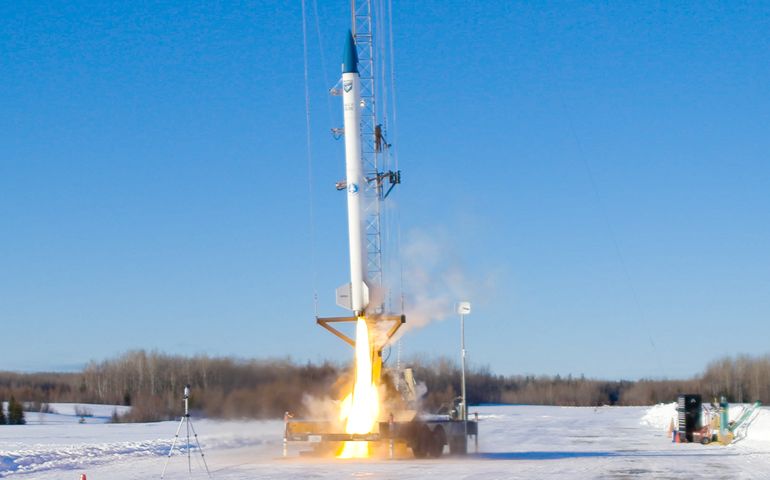As bluShift Aerospace crosses the halfway line to its crowd equity funding goal of $1.07 million, the Brunswick-based company is betting on its development of a small, dedicated launch service to break into a crowded field of companies eyeing the lucrative commercial space flight market.
“I think none that are close to launching or have launched are in the class of vehicles we’re in,” the company’s founder and CEO, Sascha Deri, told two investors during a recent virtual Q&A.
Deri addressed questions posed by Ed Harris, chief development officer at the W.M. Keck Observatory in Hawaii, and Gregory Falco, a Harvard University space security researcher.
Scores of companies are in the process of developing rockets to take small payloads to space.
“We believe we can provide a small launch experience, which it seems no one else is planning to provide,” Deri said.
bluShift’s advantages over competitors, he said, include lower costs for certain aspects of development.
The company’s location in Maine alone is expected to reduce the cost of launch site logistics by 90% — a tenth of what might be spent to launch elsewhere, he said.
The use of a proprietary, nontoxic solid biofuel and hybrid rocket technology simplifies the complexity of traditional rocket engines, he added. The biofuel costs less to make, uses materials easily sourced from farms and performs better than petroleum alternatives, according to Deri.
“And the fact that it’s nontoxic means our R&D expenses, our handling expenses, our logistics expenses are all far lower than you traditionally require when you’re launching a liquid fuel rocket,” he said.
Customer research
The company is in conversations with potential customers to learn how best to design its rockets and flight profiles for their research needs, Deri said.
“Our target market for both suborbital and orbital launch services is the civil and academic research market,” he said. “We’ve have had about 50 customer calls.”
For example, the plan is to maintain lower acceleration rates to space in order to avoid damaging fragile experiments, but also offer more zero-gravity time compared with competitors, he said.
The plan of providing a dedicated launch service for customers like civil and academic researchers means they can see their launches occur on the timeline they want, he said.
“We’ve been told by customers they’re really tired of having to wait a long time, being delayed by the primary payload,” he said. “And they love that we make them the primary payload customer.”
To further accommodate customers, bluShift plans to make its bays configurable for specific payload sizes and shapes, up to certain size and weight limits defined by the payload bays — even making it possible to “blow” the windows at altitude for customers who want their experiments to have direct access to space.
“The idea is we don’t want to restrict our customers,” he said.
Starless Rogue
On Jan. 31, bluShift launched its prototype rocket, the 20-foot-high Stardust, from Loring Commerce Centre in Limestone.
With 2,000 pounds of thrust, Stardust flew to about 4,000 feet, carrying several small customer payloads. The launch positioned the team to build a full-size engine, called the Modular Adaptable Rocket Engine for Vehicle Launch, or MAREVL for short, for successively larger rockets.
The engine will go into the next rocket iteration — the 50-foot-tall Starless Rogue, which is expected to produce 20,000 pounds of thrust and reach 40,000 feet on its demonstration flight.
The plan is to perform an initial launch of Starless Rogue a few miles up next summer, said Deri.
“If that goes successfully, we’ll launch again all the way to space for the first time,” he said.
Within three years after that, the plan is to ramp up to eight suborbital flights per year. The flights will occur from spring to fall.
Around 2024, he said, the plan is to have the first test launch of the next iteration, a 78-foot rocket dubbed Red Dwarf that will be designed as a polar low-earth orbit launch vehicle to carry a total payload of up to 30 kilograms, or 66 pounds. Over the course of about six years, the number of launches would be ramped up to two or three times per month, he said.
Orbital rockets maintain continuous flight around the earth. Suborbital rockets fly up to a certain height, then return to Earth.
As of this morning, over 600 investors had committed $546,282 toward bluShift’s $1.07 million Wefunder crowd equity campaign.
Deri has been scouting potential sites along the Downeast coast for a new launch site.
“Due to the great distance of Starless Rogue flights, we want to launch on the coast and fly over water to be as safe as possible,” a recent bluShift newsletter said. “Cape Canaveral, Wallops, Vandenberg, Kodiak, and Launch Complex 1 in Mahia are all on the coast for this reason.
“With its high latitude, south-facing coastline, and land access to the contiguous U.S., Maine can launch to the south over the ocean unlike any other state on the eastern seaboard. This is great for suborbital flights, but especially important for launches to polar orbits.”

Satellites on a polar orbit move around the earth from pole to pole. Advantages include the ability to monitor the entire earth as it spins below the satellite on its journey. It contrast with geostationary orbits, which hover over fixed geographic locations. But polar orbits provide only twice-a-day temporal coverage of any given spot, as compared with the continuous coverage of a geostationary satellite.
